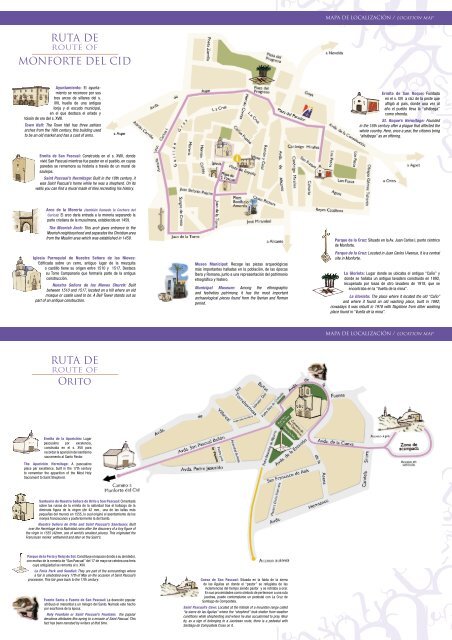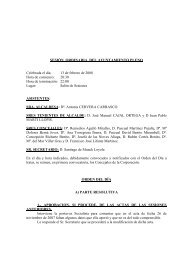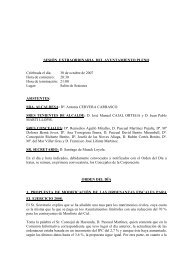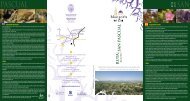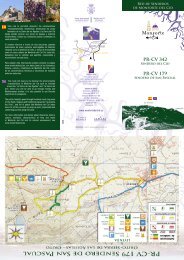RUtAS MONFORtE ORitO - Ayuntamiento de Monforte del Cid
RUtAS MONFORtE ORitO - Ayuntamiento de Monforte del Cid
RUtAS MONFORtE ORitO - Ayuntamiento de Monforte del Cid
Create successful ePaper yourself
Turn your PDF publications into a flip-book with our unique Google optimized e-Paper software.
RUTA DE<br />
route of<br />
MONFORTE DEL CID<br />
<strong>Ayuntamiento</strong>: El ayuntamiento<br />
se reconoce por sus<br />
tres arcos <strong>de</strong> sillares <strong>de</strong>l s.<br />
XVI, huella <strong>de</strong> una antigua<br />
lonja y el escudo municipal,<br />
en el que <strong>de</strong>staca el orlado y<br />
toisón <strong>de</strong> oro <strong>de</strong>l s. XVIII.<br />
Town Hall: The Town Hall has three ashlars<br />
arches from the 16th century, this building used<br />
to be an old market and has a coat of arms.<br />
Ermita <strong>de</strong> San Pascual: Construida en el s. XVIII, don<strong>de</strong><br />
vivió San Pascual mientras fue pastor en el pueblo, en cuyas<br />
pare<strong>de</strong>s se rememora su historia a través <strong>de</strong> un mural <strong>de</strong><br />
azulejos.<br />
Saint Pascual’s Hermitage: Built in the 18th century, it<br />
was Saint Pascual’s home while he was a shepherd. On its<br />
walls you can find a mural ma<strong>de</strong> of tiles recreating his history.<br />
Arco <strong>de</strong> la Morería (también llamado la Cochera <strong>de</strong>l<br />
Curica): El arco daría entrada a la morería separando la<br />
parte cristiana <strong>de</strong> la musulmana, establecida en 1459.<br />
The Moorish Arch: This arch gives entrance to the<br />
Moorish neighbourhood and separates the Christian area<br />
from the Muslim area which was established in 1459.<br />
Iglesia Parroquial <strong>de</strong> Nuestra Señora <strong>de</strong> las Nieves:<br />
Edificada sobre un cerro, antiguo lugar <strong>de</strong> la mezquita<br />
o castillo tiene su origen entre 1510 y 1517. Destaca<br />
su Torre Campanario que formaría parte <strong>de</strong> la antigua<br />
construcción.<br />
Nuestra Señora <strong>de</strong> las Nieves Church: Built<br />
between 1510 and 1517, located on a hill where an old<br />
mosque or castle used to be. A Bell Tower stands out as<br />
part of an antique construction.<br />
RUTA DE<br />
route of<br />
Orito<br />
Ermita <strong>de</strong> la Aparición: Lugar<br />
pascualino por excelencia,<br />
construida en el s. XVII para<br />
recordar la aparición <strong>de</strong>l santísimo<br />
sacramento al Santo Pastor.<br />
The Aparición Hermitage: A pascualino<br />
place par excellence, built in the 17th century<br />
to remember the apparition of the Most Holy<br />
Sacrament to Saint Shepherd.<br />
Santuario <strong>de</strong> Nuestra Señora <strong>de</strong> Orito y San Pascual: Cimentada<br />
sobre las ruinas <strong>de</strong> la ermita <strong>de</strong> la natividad tras el hallazgo <strong>de</strong> la<br />
diminuta figura <strong>de</strong> la virgen (<strong>de</strong> 42 mm., una <strong>de</strong> las tallas más<br />
pequeñas <strong>de</strong>l munco) en 1555, lo cual originó el asentamiento <strong>de</strong> los<br />
monjes franciscanos y posteriormente la <strong>de</strong>l Santo.<br />
Nuestra Señora <strong>de</strong> Orito and Saint Pascual’s Sanctuary: Built<br />
over the Hermitage <strong>de</strong> la Natividad ruins after the discovery of a tiny figure of<br />
the virgin in 1555 (42mm, one of world’s smallest pieces). This originated the<br />
Franciscan monks’ settlement and later on the Saint’s.<br />
Parque <strong>de</strong> la Feria y Reloj <strong>de</strong> Sol: Constituye el espacio don<strong>de</strong> a su alre<strong>de</strong>dor,<br />
con motivo <strong>de</strong> la romería <strong>de</strong> “San Pascual” <strong>de</strong>l 17 <strong>de</strong> mayo se celebra una feria<br />
cuya antigüedad se remonta al s. XVII.<br />
La Feria Park and Sundial: They are part of the surroundings where<br />
a fair is celebrated every 17th of May on the occasion of Saint Pascual’s<br />
procession. This fair goes back to the 17th century.<br />
Fuente Santa o Fuente <strong>de</strong> San Pascual: La <strong>de</strong>voción popular<br />
atribuyó el manantial a un milagro <strong>de</strong>l Santo. Narrado este hecho<br />
por escritores <strong>de</strong> la época.<br />
Holy Fountain or Saint Pascual’s Fountain: the popular<br />
<strong>de</strong>votions attributes this spring to a miracle of Saint Pascual. This<br />
fact has been narrated by writers at that time.<br />
Museo Municipal: Recoge las piezas arqueológicas<br />
más importantes halladas en la población, <strong>de</strong> las épocas<br />
Íbera y Romana, junto a una representación <strong>de</strong>l patrimonio<br />
etnográfico y festero.<br />
Municipal Museum: Among the ethnographic<br />
and festivities patrimony, it has the most important<br />
archaeological pieces found from the Iberian and Roman<br />
period.<br />
Ermita <strong>de</strong> la Aparición:<br />
Lugar pascualino por<br />
excelencia, construida en<br />
el s. XVII para recordar la<br />
aparición <strong>de</strong>l santísimo<br />
sacramento al Santo Pastor.<br />
The Aparición Hermitage: A<br />
pascualino place par excellence, built<br />
in the 17th century to remember the<br />
apparition of the Most Holy Sacrament<br />
to Saint Shepherd.<br />
Cueva <strong>de</strong> San Pascual: Situada en la falda <strong>de</strong> la sierra<br />
<strong>de</strong> las Águilas en don<strong>de</strong> el “pastor” se refugiaba <strong>de</strong> las<br />
inclemencias <strong>de</strong>l tiempo siendo pastor y se retiraba a orar.<br />
En sus proximida<strong>de</strong>s como símbolo <strong>de</strong> pertenecer a una ruta<br />
jacobea, pue<strong>de</strong> contemplarse un pe<strong>de</strong>stal con La Cruz <strong>de</strong><br />
Santiago <strong>de</strong> Compostela.<br />
Saint Pascual’s Cave: Located at the hillsi<strong>de</strong> of a mountain range called<br />
“la sierra <strong>de</strong> las Águilas” where the “shepherd” took shelter from weather<br />
conditions while shepherding and where he also accustomed to pray. Near<br />
by, as a sign of belonging to a Jacobean route, there is a pe<strong>de</strong>stal with<br />
Santiago <strong>de</strong> Compostela Cross on it.<br />
MAPA DE LOCALIZACIÓN / location map<br />
Ermita <strong>de</strong> San Roque: Fundada<br />
en el s. XVI a raíz <strong>de</strong> la peste que<br />
afligió al país, don<strong>de</strong> una vez al<br />
año el pueblo lleva la “alhábega”<br />
como ofrenda.<br />
St. Roque’s Hermitage: Foun<strong>de</strong>d<br />
in the 16th century after a plague that affected the<br />
whole country. Here, once a year, the citizens bring<br />
“alhábega” as an offering.<br />
Parque <strong>de</strong> la Cruz: Situado en la Av. Juan Carlos I, punto céntrico<br />
<strong>de</strong> <strong>Monforte</strong>.<br />
Parque <strong>de</strong> la Cruz: Located in Juan Carlos I Avenue, it is a central<br />
site in <strong>Monforte</strong>.<br />
La Glorieta: Lugar don<strong>de</strong> se ubicaba el antiguo “Caño” y<br />
don<strong>de</strong> se hallaba un antiguo lava<strong>de</strong>ro construido en 1892,<br />
recuperado por losas <strong>de</strong> otro lava<strong>de</strong>ro <strong>de</strong> 1918, que se<br />
encontraba en la “Vuelta <strong>de</strong> la mina”.<br />
La Glorieta: The place where it located the old “Caño”<br />
and where it found an old washing place, built in 1892;<br />
nowadays it was rebuilt in 1918 with flagstone from other washing<br />
place found in “Vuelta <strong>de</strong> la mina”.<br />
MAPA DE LOCALIZACIÓN / location map


